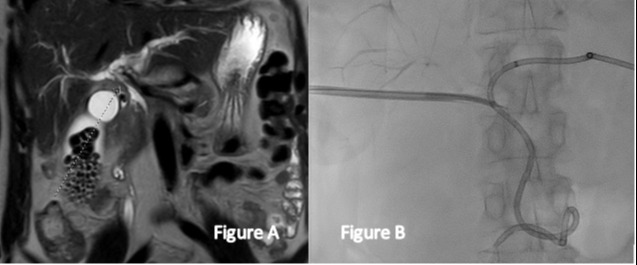Back
Poster Session C - Monday Afternoon
C0040 - A Novel Approach to Obtaining Tissue in a Difficult to Access Indeterminate Biliary Stricture: Percutaneous Cholangioscopy and Biopsy
Monday, October 24, 2022
3:00 PM – 5:00 PM ET
Location: Crown Ballroom

Abigail Schubach, MD
University of Rochester Medical Center
Rochester, NY
Presenting Author(s)
Award: Presidential Poster Award
Abigail Schubach, MD, Amulya Penmetsa, MD, Ashwani K. Sharma, MD, Shivangi Kothari, MD
University of Rochester Medical Center, Rochester, NY
Introduction: When evaluating biliary strictures, establishing a diagnosis can present challenges. We present a case of percutaneous transhepatic cholangioscopy (PTCS) using the Spyglass (SG) DS cholangioscope, resulting in a definitive diagnosis of a cholangiocarcinoma after previous failed attempts by several standard methods.
Case Description/Methods: A 59 year old female presented with one week of epigastric pain, jaundice and pruritus. Alkaline phosphatase, direct bilirubin and CA 19-9 were elevated. Magnetic resonance imaging (MRI) showed intrahepatic biliary ductal dilation with cutoff near the hepatic hilum, concerning for cholangiocarcinoma (Figure A). Endoscopic retrograde cholangiopancreatography (ERCP) showed luminal narrowing in the duodenal sweep with edema and ulcerations, and biopsies from stricture showed small bowel inflammation. Interventional radiology (IR) performed direct biliary duct biopsy that showed atypical epithelial cells. Endoscopic ultrasound (EUS) with fine needle aspiration (FNA) of a hypoechoic soft tissue area in the gallbladder neck showed acute inflammation. To ultimately reach a diagnosis, percutaneous access was obtained by IR and a SG DS cholangioscope was advanced percutaneously through the IR placed sheath. The common hepatic duct stricture was accessed from above to obtain biopsies, which were positive for adenocarcinoma (Figure B). The patient was then started on chemotherapy.
Discussion: While ERCP with brushings is the first line method to evaluate biliary strictures, tissue yield has low sensitivity (41.6%). Tortuous duodenal or cholangial anatomy can also prevent access to the target area. EUS-FNA has the highest tissue sensitivity at 93.8% but can also present anatomic restrictions. Traditionally, PTCS has been the answer for biopsies unable to be obtained with the modalities above but requires large tract dilation and days of sinus tract maturation to allow for a scope. SG assisted PCTS has been reported to have superior sensitivity, smaller dilation requirement, and less adverse events when compared to traditional PCTS. However, reports of SG with a transcutaneous approach are extremely limited. Our case highlights a multi-disciplinary approach with SG assisted PTCS in diagnosing malignancy when standard methods were unsuccessful, positioning SG as an important tool for future evaluation of indeterminate biliary stricture.

Disclosures:
Abigail Schubach, MD, Amulya Penmetsa, MD, Ashwani K. Sharma, MD, Shivangi Kothari, MD. C0040 - A Novel Approach to Obtaining Tissue in a Difficult to Access Indeterminate Biliary Stricture: Percutaneous Cholangioscopy and Biopsy, ACG 2022 Annual Scientific Meeting Abstracts. Charlotte, NC: American College of Gastroenterology.
Abigail Schubach, MD, Amulya Penmetsa, MD, Ashwani K. Sharma, MD, Shivangi Kothari, MD
University of Rochester Medical Center, Rochester, NY
Introduction: When evaluating biliary strictures, establishing a diagnosis can present challenges. We present a case of percutaneous transhepatic cholangioscopy (PTCS) using the Spyglass (SG) DS cholangioscope, resulting in a definitive diagnosis of a cholangiocarcinoma after previous failed attempts by several standard methods.
Case Description/Methods: A 59 year old female presented with one week of epigastric pain, jaundice and pruritus. Alkaline phosphatase, direct bilirubin and CA 19-9 were elevated. Magnetic resonance imaging (MRI) showed intrahepatic biliary ductal dilation with cutoff near the hepatic hilum, concerning for cholangiocarcinoma (Figure A). Endoscopic retrograde cholangiopancreatography (ERCP) showed luminal narrowing in the duodenal sweep with edema and ulcerations, and biopsies from stricture showed small bowel inflammation. Interventional radiology (IR) performed direct biliary duct biopsy that showed atypical epithelial cells. Endoscopic ultrasound (EUS) with fine needle aspiration (FNA) of a hypoechoic soft tissue area in the gallbladder neck showed acute inflammation. To ultimately reach a diagnosis, percutaneous access was obtained by IR and a SG DS cholangioscope was advanced percutaneously through the IR placed sheath. The common hepatic duct stricture was accessed from above to obtain biopsies, which were positive for adenocarcinoma (Figure B). The patient was then started on chemotherapy.
Discussion: While ERCP with brushings is the first line method to evaluate biliary strictures, tissue yield has low sensitivity (41.6%). Tortuous duodenal or cholangial anatomy can also prevent access to the target area. EUS-FNA has the highest tissue sensitivity at 93.8% but can also present anatomic restrictions. Traditionally, PTCS has been the answer for biopsies unable to be obtained with the modalities above but requires large tract dilation and days of sinus tract maturation to allow for a scope. SG assisted PCTS has been reported to have superior sensitivity, smaller dilation requirement, and less adverse events when compared to traditional PCTS. However, reports of SG with a transcutaneous approach are extremely limited. Our case highlights a multi-disciplinary approach with SG assisted PTCS in diagnosing malignancy when standard methods were unsuccessful, positioning SG as an important tool for future evaluation of indeterminate biliary stricture.

Figure: Figure (A) MRI showing intrahepatic ductal dilation with cutoff at the hilum and prominent perihilar soft tissue. Figure (B) showing Spyglass DS cholangioscope advancing through PTC to obtain biopsies from hilar stricture
Disclosures:
Abigail Schubach indicated no relevant financial relationships.
Amulya Penmetsa indicated no relevant financial relationships.
Ashwani Sharma indicated no relevant financial relationships.
Shivangi Kothari: Boston Scientific – Consultant. Castle Biosciences – Advisory Committee/Board Member. Olympus – Consultant.
Abigail Schubach, MD, Amulya Penmetsa, MD, Ashwani K. Sharma, MD, Shivangi Kothari, MD. C0040 - A Novel Approach to Obtaining Tissue in a Difficult to Access Indeterminate Biliary Stricture: Percutaneous Cholangioscopy and Biopsy, ACG 2022 Annual Scientific Meeting Abstracts. Charlotte, NC: American College of Gastroenterology.


